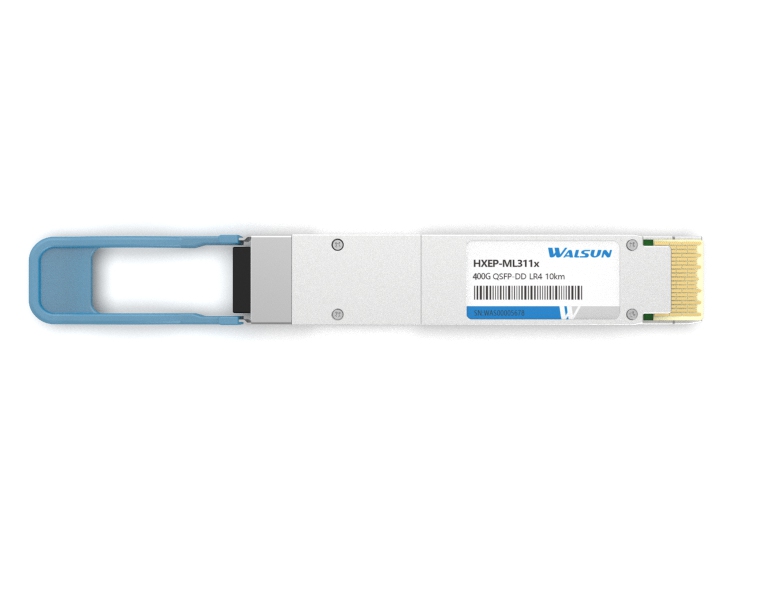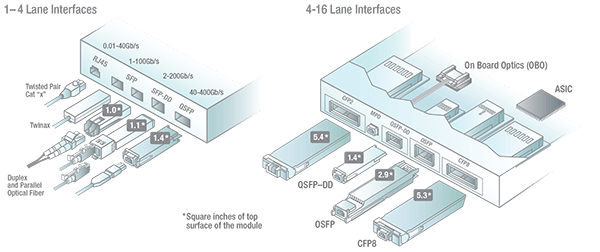

 Knowledge Base +
Knowledge Base +  2023.11.30
2023.11.30QSFP-DD stands for Quad Small Form-factor Pluggable Double Density. It is a high-speed, high-density data communication interface used in networking and telecommunications equipment. QSFP-DD modules have a compact form factor and can support multi-gigabit data rates, making them suitable for high-speed data transmission in data centers and other networking applications.

Why QSFP-DD over other 400G capable form factors (OSFP, CFP8, & COBO)?
When compared to the octal small form pluggable (OSFP), the QSFP-DD is quite similar. Both utilize eight lanes to achieve 400G data rates (8x50G), however, the OSFP is planned to later support 800G signals. The QSFP-DD is a better option for those needing the interim step to 200G not only for cost, but also due to reduced power consumption.
OSFP tends to be a better choice for operators immediately moving to 400G with desire for later scalability, however, OSFP is not backwards compatible with QSFP+ and its other forms. This means a move to 400G will come at a higher immediate cost with OSFP with savings later realized by deferring further cost at the 800G upgrade.

Relative form factor footprints (courtesy of Ethernet Alliance)
CFP8 is another popular form factor for 400G applications due to its support for both 16x25G and 8x50G, however, it has a much larger physical footprint as well as in elevated power consumption levels. Unfortunately it is neither backwards compatible nor scalable to 800G.
Our final current option is the unique consortium for on-board optics (COBO). Though newer, this type is installed in the line-card. This installation method puts many features of the QSFP-DD out of reach for a COBO, such as lacking the flexibility provided by a hot-pluggable optic. Through an 8 lane 1x400G or a 16 lane 2x400G connector interface, however, it can support both 400G and 800G.
What is an SFP Transceiver?
SFP stands for small form-factor pluggable. It is also known as a 鈥渕ini-GBIC鈥? (gigabit interface converter). An SFP transceiver is a tiny transceiver that links fiber optic cables to various networking devices such as switches, routers, network cards, and wireless access points. Multiple SFP transceivers are available, depending on data rate and application, including 155M SFP, 622M SFP, 1G SFP, 2.5G SFP, 2G/4G Fiber Chanel SFP, 3G SFP, and 6G SFP. They are used in fiber-optic Ethernet networks, particularly common in commercial networks. SFP transceivers are one of the most widely utilized fiber-optic networking equipment nowadays.
What is an SFP+ Transceiver?
Compared to SFP transceivers, SFP+ transceivers are a more advanced version of the technology. SFP+ transceivers are most typically offered at 8Gbps, 10Gbps, or 16Gbps. They have the exact dimensions of SFPs, making it simple to integrate them into existing infrastructure. SFP+ transceiver is one of the most popular data center cabling applications.
Depending on the application, the SFP+ transceiver can be divided into five broad categories: Dual Fiber SFP+, BiDi SFP+, Copper SFP+, CWDM SFP+, and DWDM SFP+.
What is the SFP28 Transceiver?
SFP28 stands for Small Form-Factor Pluggable 28. It is the third generation of SFP connection systems built for 25G throughput following the IEEE 802.3by specification (25GBASE-CR). The SFP28 is an improved version of the SFP+ designed for 25G signal transmission. The SFP28 has the typical form factor as the SFP+, but it offers 25Gbps electrical connections per channel. Compared with SFP+, SFP28 provides a much higher bandwidth capability.
Depending on the application, the SFP28 transceiver can be divided into six broad categories: Dual Fiber SFP28, BiDi SFP28, CWDM SFP28, DWDM SFP28, SFP28 DAC, and SFP28 AOC.
What is a QSFP+ Transceiver?
QSFP+, often known as QSFP, is an abbreviation for quad (4-channel) small form-factor pluggable. QSFP+ optics is yet another tiny, hot-pluggable transceiver used in data transmission. Compared to SFP+, QSFP+ supports 4x10G or 4x14G SFP+ data rates to enable increased bandwidth capabilities. It provides several data rate options for Ethernet, Fibre Channel, InfiniBand, and SONET/SDH technologies.
What is a QSFP28 Transceiver?
QSFP28 is an abbreviation for quad small form-factor pluggable 28. The QSFP28 transceiver is intended for use with 100 Gigabit Ethernet, EDR InfiniBand, or 32G Fibre Channel networks. The QSFP28 100G transceiver has four high-speed differential signal channels with data rates ranging from 25 Gbps to 40 Gbps. In the 100G optics market, QSFP28 transceivers are more popular than CFP, CFP2, and CFP4 form factors.
What is a QSFP-DD Transceiver?
Quad Small Form Factor Pluggable Double Density (QSFP-DD) is also known as QSFP56-DD. The QSFP-DD transceiver is a new optical module comparable to the current QSFP but adds an extra row of contacts for an eight-lane electrical interface. All QSFP-DD-based transceivers from 40G to 200G are backward compatible with QSFP+. In a single rack unit (RU), QSFP-DD can support 36 400GbE ports, with a total bandwidth of nearly 14Tb/s.
What is an OSFP Transceiver?
The OSFP acronym stands for Octal Small Form-factor Pluggable. The OSFP MSA designed it. Google launched the OSFP MSA group, which Arista Networks heads. OSFP is a revolutionary pluggable form factor that offers eight high-speed electrical channels at 400 Gbps (8x50G or 4x100G). However, it supports 32 OSFP ports per 1U front panel and 14.4 Tbps per 1U swap slot. OSFP optics with improved signal integrity and thermal performance are being developed to suit the next generation of 800G optics. The OSFP may also be used with 100G QSFP optics.
Q&A
1、What is 400G QSFP-DD optical module?
A:400G optical module refers to the optical module products whose transmission rate reaches 400Gbps. Currently the mainstream packaging type is QSFP-DD and OSFP, QSFP-DD is a high-speed optical module interface specification, the upgraded version of the QSFP interface, support for 400G high-speed transmission. Using optical fiber as the signal transmission medium, by converting electrical signals into optical signals and transmitting them in the optical fiber.
2、What are the common types of 400G QSFP-DD optical modules in the market?
A: The common 400G QSFP-DD optical modules in the market have the following types in the market: QSFP-DD SR8, QSFP-DD DR4, QSFP-DD FR4, QSFP-DD FR8, QSFP-DD LR4, QSFP-DD LR8 and QSFP-DD ER8 optical modules.
3、What is the difference between QSFP-DD and OSFP optical modules?
A: QSFP-DD is smaller in size and more suitable for data center applications, which is the mainstream development direction, while OSFP is slightly larger in package size and consumes more power, which is more suitable for telecom applications. In contrast, the QSFP-DD interface provides four-channel small size and double the port density, OSFP for eight high-speed electrical channels, the current point of view of the QSFP-DD good compatibility and perfect support for 400G is still the preferred choice of the market.
4、What is the transmission distance of 400G QSFP-DD optical module?
A: The transmission distance of 400G QSFP-DD module depends on the type of fiber used and the specifications of the module. Generally speaking, it can support a transmission distance of 100m-40km.
5、What are the application scenarios of Walsun 400G QSFP-DD optical modules?
A: 400G QSFP-DD optical modules are usually used in high-bandwidth requirement scenarios such as internal connection in data centers, interconnection of data centers, and connection between network devices.
Subscribe to the newsletter
for all the latest updates.
2-5# Building, Tongfuyu Industrial Zone, Aiqun Road, Shiyan Street, Baoan District, Shenzhen. China
